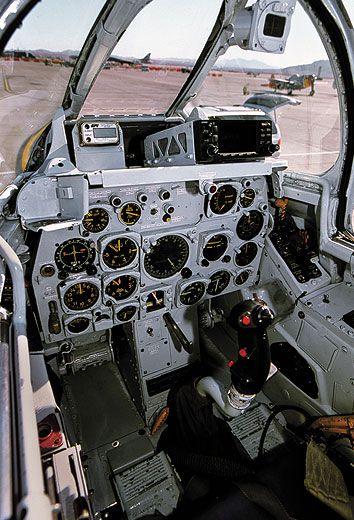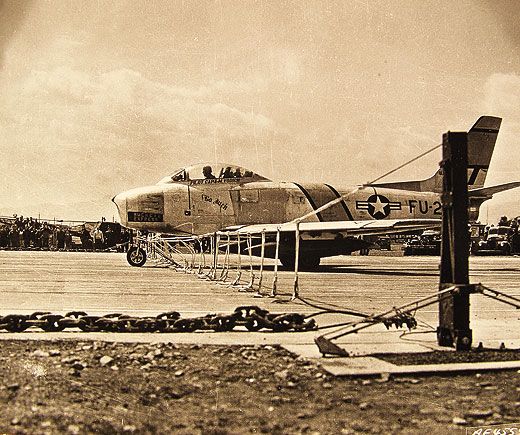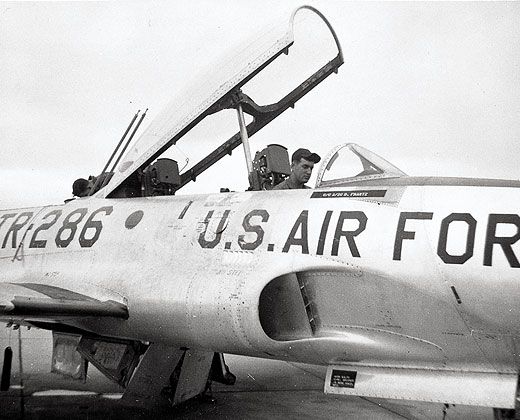Mind If I Borrow It?
The day an Air Force mechanic commandeered a North American F-86
/https://tf-cmsv2-smithsonianmag-media.s3.amazonaws.com/filer/Mind_If_I_Borrow_It_11-01-11_1_FLASH.jpg)
Even as the powerful F-100 and other Century Series jets were carrying the U.S. Air Force to supersonic speeds in the 1950s, the North American F-86 Sabre was still a trusted fighter. Its reputation as a MiG killer, earned during the Korean War, made flying the Sabrejet a young airman’s dream. It wasn’t easy, especially considering the competition. Many F-86 pilots were World War II veterans with combat experience.
New Sabre pilots faced at least a year of training, including several hundred hours of classroom work and several hundred more of dual and solo flight time. After that came 15 hours in a cockpit simulator. During the student’s first flight in the single-seat fighter, an instructor flew on his wing, teaching via radio.
And then there was Airman First Class George R. Johnson. A 20-year-old mechanic at Williams Air Force Base in Arizona, Johnson skipped the preliminaries; on the evening of September 20, 1956, he took a Sabrejet up for a ride. Up to then, Johnson’s piloting experience amounted to two hours with an instructor in a Piper Cub.
I learned about Johnson from an article in the now-defunct Argosy magazine, published in February 1959. At the time, I was a senior at Iowa State University studying aeronautical engineering and in the Air Force Reserve Officer Training Corps program. (I was commissioned in November 1959 and entered active duty the following January.) There were no quotes from Johnson in the Argosy story, and the piece did not say what happened to him after his adventure. I always wondered about him, and when I asked around in the rather large community of former F-86 pilots, I was surprised to find how little anyone knew about his exploit. After retiring from the Air Force, I decided to look him up.
Now 75, Johnson was amazed that anyone would still be interested in his long-ago flight. An intensely private man, he nonetheless agreed to meet me at a motel in Safford, Arizona, near his hometown, last November.
He grew up fascinated with airplanes. Johnson still remembered the bright yellow AT-6 Texan trainer that buzzed his family’s Pima home early in World War II. After his family moved to Los Angeles, he rode his bicycle to Inglewood to watch airplanes take off and land at the airport. At 17, with a letter of permission from his mother, the underage Johnson enlisted in the Air Force in January 1954. He got his first airplane ride on a chartered Convair 240 to Lackland Air Force Base in Texas for basic training. Having worked on cars in high school, Johnson had mechanical skills, and so was sent to jet engine school at Chanute Air Force Base in Illinois. There, he accompanied pilots in the T-6, rode in the nose of a B-25, and in his spare time logged Cub flight time. Though Johnson dearly wanted to fly for the Air Force, he knew he never would; as a boy, he had stared at the sun during an eclipse and had slightly burned one retina, making it impossible for him to pass the physical for military pilots.
In October 1955, Johnson arrived at Williams, about 30 miles southeast of Phoenix. The base was just beginning to transition from a basic training site, where students flew the Lockheed T-33 Shooting Star jet trainer, to an advanced fighter training base stocked with F-86s. Assigned to the 3525th Periodic Maintenance Squadron as a T-33 mechanic, Johnson did hydraulic and electrical repairs, engine changes, flight control and system checks, and flight instrument calibrations. He learned how to start and run the engine, and how to taxi the aircraft.
Johnson was proficient enough to be reassigned to the Sabre early the next year. On September 20, he and several other mechanics were working the evening shift on the flightline. The day shift had done major maintenance on an F-86F, no. 52-5039, but the work had not been done correctly; as a result, one of the aircraft’s control cables became inoperative. Fixing it required that the aft section of the Sabre be pulled off, the cables realigned, and then the aft reinstalled before all wiring, cables, and tubing could be reconnected.
Before the evening shift’s work could be signed off on, the mechanics had to perform a functional check, to be followed the next morning by a pilot’s flight check. While one mechanic connected a ground power unit to the aircraft, Johnson gave the Sabre an external check, grabbed his headset and microphone from his toolbox, climbed into the cockpit, and started the engine. Normal procedures called for the aircraft to be taxied to a run-up area, a short concrete spur near the active runway, where the engine could be monitored for normal operation up to full power.
Donning his headset, Johnson called the control tower, manned by Airman First Class Theodore Davis Jr., who cleared him to taxi to the run-up area. A few minutes later, after the engine check, Johnson called again and asked for permission to use the runway for a high-speed taxi test—a common procedure after any work on the brakes or nosewheel. The F-86 had a history of problems in which the nosewheel shimmied, so the damping mechanism had to be carefully adjusted. Davis again granted clearance, and watched as Johnson taxied the Sabre to the active runway, 30L, which was seldom used at night.
“My intentions were still just to do a high-speed taxi,” Johnson recalled. “I never had a conscious intention to fly that airplane. The nose lifts off the runway at about 105 knots [120 mph]. As I approached 105, I could feel the nose getting light, and I thought I would just wait a few more seconds to see if I could feel the plane getting light on the main gear. The few seconds passed, and I just didn’t think I had enough room to stop. I wasn’t thinking about being in trouble. I was thinking about maintaining climb airspeed, and when I was in a definite climb, I retracted the landing gear. I was off and committed. There was no wind at all that night. The air was smooth as glass.” The time was 10:34 p.m.
Reaction on the ground was immediate. As the F-86 climbed northwest into the moonlit sky, Davis tried, unsuccessfully, to contact it. He then alerted the Officer of the Day, Captain Robert McCormick, who in turn notified other officers, including the base commander, Colonel Jerry Page, and the fire chief, Edward Anderson.
As all of them converged on the airfield, Johnson finally came on the radio, calmly announced that he had taken off, and asked what the tower thought he should do. McCormick, who by then had arrived in the tower, asked Johnson to orbit eight or 10 miles from the base and to avoid flying over residential areas. McCormick, who was an F-86 pilot, talked Johnson through the proper engine power adjustments to conserve fuel and to cease his climb and level the aircraft.
Johnson told me that while he was a bit apprehensive about his predicament, he was not afraid for his life. “I knew that airplane,” he said, “and I knew the numbers on various approach speeds because I knew the pilot’s handbook. I knew that intimately. Spent a lot of time studying that. I was as prepared as you could be without actually flying.
“The F-86 had one nasty characteristic. You could get into trouble on takeoff. If you lifted the nose too high at 105 [knots], then you get [too much] drag, and it wouldn’t accelerate out of it. You had to put the nose down to get the speed on up.
“I knew all about things like that, so I flew the airplane largely with trim. I knew all about over-controlling. I wasn’t gonna do aerobatics or anything like that. It was very stable. And it instantly obeyed where I told it I wanted to go. I just spent my time at 10,000 feet circling the base.”
Though Johnson wasn’t worried, the men on the ground were. For one thing, Johnson had no parachute. His only hope, base officials felt, was to make a survivable landing with their help. “There was quite a lot of [radio] chat back and forth,” Johnson recalled. “Everything got pretty well stabilized with me at slow cruise and orbiting the base. I could see everything moving on the taxiways and runways. I don’t recall being frightened, although I was being very careful with the controls.”
Johnson asked the tower to contact Second Lieutenant George Madison to come and fly on his wing. Madison, an F-86 check pilot, had until recently been Johnson’s supervisor, and Johnson respected and trusted him. One of the senior maintenance officers, Captain Linden Kelly, also a pilot, rousted Madison from bed and briefed him on the situation. Madison quickly dressed, grabbed his flight gear, helmet, and parachute, and rushed to the flightline, where a crew had readied an F-86. Madison asked Kelly to accompany him in another F-86. Within minutes, both were airborne.
“The F-86F is very stable in smooth air and the night was smooth,” Madison told me via e-mail (he wouldn’t say where he lived). “I knew that if we could get him in a controlled descent of about 500 feet per minute at around 140 knots [161 mph] and keep him lined up with the runway, there was a chance he might survive. I told George to just relax when the aircraft smacked the runway and keep it straight. All the time I was hoping the aircraft would not bounce or porpoise. I told George to forget about the brakes and let the barrier stop the aircraft.”
Said Johnson: “When we turned to final approach, they [Madison and Kelly] had me lined up with the runway very nicely. On their instructions, I had extended the speed brakes and landing gear, and put the wing flaps down. Madison had me back off the throttle at just the right time, and I touched down very smoothly, right on the runway centerline. I saw both of them accelerate and begin climbing away. One of them said ‘Good boy’ as I touched down.”
Even though he had come in faster than normal touchdown speed, Johnson had lots of experience in braking and steering the aircraft. Still, he took Madison’s advice and let the Sabre roll the length of the runway and plow into the cable barrier.
“It seemed to me that I was still very fast and not at all sure about getting stopped. I stayed off the brakes and was still rolling quite fast as I hit the barrier target right in the middle. The barrier engaged very smoothly and quickly slowed me down to a stop.”
Johnson opened the canopy and shut down the avionics and navigation lights. Anderson, the fire chief, ran over, hopped up on a wing, and leaned into the cockpit, where Johnson was cleaning things up. “This bird really can fly by itself,” Johnson told Anderson in amazement, adding, “It’s all over now but the shouting.”
And it was. Johnson had flown an F-86 for one hour and two minutes. For his adventure, he was whisked off to the base hospital, given a blood test (presumably to check for drugs and alcohol), and confined for the night in a guarded room.
The next morning, Page, the base commander, came in and opened the conversation with “Well, what do we do now?” Johnson had expected a tongue-lashing, but found the colonel to be a kind man. Page told Johnson that he had put on quite a show of flying skill, and under other circumstances Page might even have considered recommending him for pilot training. However, Page said, a court-martial was inevitable. If he were to show leniency, he told Johnson, “I would have half of my mechanics trying the same damn fool stunt tomorrow.”
Johnson’s general court-martial was held on March 26, 1957. The mechanic faced three charges: stealing an F-86F (valued at $217,427), causing $195.64 worth of damage to the aircraft when he hit the barrier upon landing, and flying the aircraft without proper flight orders or clearance. The trial lasted a day, and a transcript shows that members of the court were keenly interested in whether Johnson had seemed distraught or had hinted that he intended to fly the aircraft. Witnesses who spoke with him on the radio that night, and those who listened in, were unanimous: He seemed calm and completely in control of the situation.
Ultimately, the court agreed that Johnson had not intended to steal the Sabre. He was allowed to plead guilty to a lesser charge: wrongful appropriation. He was found guilty on the second charge of damaging the aircraft but was acquitted on the third on the grounds that the regulation applied only to Air Force pilots.
The court sentenced him to six months confinement at hard labor, which reduced his rank to Airman Basic, plus he had to forfeit $65 a month for six months. But Johnson was not discharged. He served his time in the jail at Williams, and looks back on his imprisonment as not at all depressing. Daily he was allowed outside to serve on various work details, such as mowing grass. His cell door was seldom locked, and he spent many evenings playing cards with the guards. For good behavior, he was freed after five months.
The Air Force put Johnson back to work in a different maintenance squadron, and at a desk, rather than on the flightline. Given charge of the technical and maintenance library, he soon excelled and began to earn back his rank. Johnson served another two years at Williams until the base began a transition to training pilots in the new F-100 Super Sabre. In early 1960, he was transferred to Kadena Air Base in Okinawa, Japan, and assigned to the headquarters of the 18th Tactical Fighter Wing. Following his overseas tour, Johnson opted not to re-enlist, and in late 1961 he was released from active duty as an Airman Second Class (equivalent to today’s Airman First Class or E-3).
Johnson went on to work in the computer industry as a customer engineering and service representative. He eventually earned his pilot’s license, flew cropdusters, and for a time owned a Mooney M20 four-seat airplane. He did not consider his Sabrejet flight a big event in his life. “It was kind of a dumb thing to do, but I got away with it,” he told me. “Had a guardian angel on my shoulder that night.”
When the F-86 was rolling out to U.S. bases in the 1950s, North American Aviation dispatched its legendary test pilot, Bob Hoover, to show the fighter’s safe handling and flying capabilities to Air Force pilots all over the world. Hoover’s demonstrations—which included barrel rolls immediately after takeoff—were meant to allay concerns about the stability of the new swept-wing aircraft at low speeds, and to reassure pilots of the ease of flying the Sabre. Too late came Airman Johnson and his amazing one-hour flight to provide the ultimate proof.
Paul D. Mather is a lifelong self-admitted aviation nut who has never read or heard an uninteresting airplane story.


